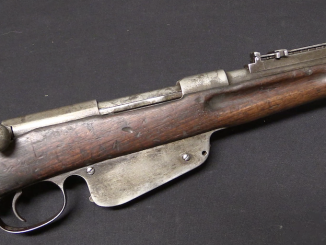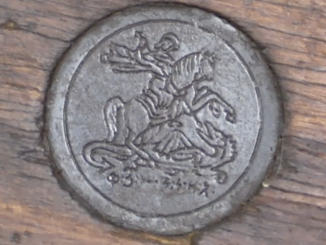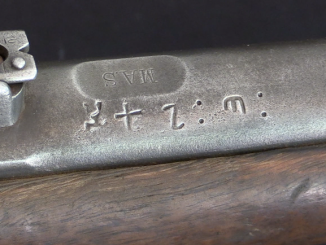This rifle began life as a German Gewehr 88 rifle in German military service. It was sent to Ethiopia, marked in Amharic, and then at some point cut down to carbine length. The shortened gun retains the infantry-type side bayonet lug and front sight, but has a slightly bent bolt handle and no rear sight at all. This is definitely not a factory configuration, but I don’t know when the changes to it were made…
Thanks to InterOrdnance for giving me access to look at some of these Ethiopian-import rifles! You can find a wide variety of C&R rifles available at their sales site, RoyalTigerImports.com .




This may have just solved a “mystery Lebel” carbine I have with some funky markings I had never seen before…
The use of what appears to be a bathrobe belt as a sling is something I would do 🙂
When I think of the money we spent on leather sling straps in my youth and much later, when we could have done as well or better with strips of blanket, I want to hang my head and go “Aw shoot,” or some similar word.
No rear sight? Sounds like a hasty emergency conversion when no other items were on the shelf! The approach is simple: point and shoot, assuming the targeted person is within barnyard range. I could be wrong.
There is still traces visible of where the rear sight used to be. I think it just got lost to time.
Is it possible that the weapon was used to fire shot of some variety?
It’s also not out of the question that some local just didn’t care for the rear sight and could shoot just as well with only the front post. Something like the old revolver just being an extension of the shooter’s hand. “Don’t aim, son, jes point like yuh would yo finger and that lead’ll go what yuh want it. “
This old campaigner has definitely been “rode hard and put away wet”.
But I suspect that the conversion from rifle to carbine took place before it left its homeland.
The reason is that marking on the barrel band.
Ba.R.2.125
That translates to “Bavarian (army) 2nd Reiter (cavalry)(division), No. 125.”
Yes, I know, normally it would be K for “Kavallerie”, but the Bavarian Army used “R” (for “Reiter” aka “Ritter”-“Knight”) for its cavalry units. They also had their own numbering series for units and etc., declining the honor of having them lumped in with all those lowland Germans.
The best guess is that they ran short of “proper” cavalry arms and this was an arsenal conversion.
I’ll go out on limb and suggest that this one was converted during WW1, when everybody in Europe was short of everything, and ended up in Ethiopia in the 1920s.
It probably acquired the sling, and lost its rear sight, during the Second Italo-Ethiopian War in 1935-37;
https://en.wikipedia.org/wiki/Second_Italo-Ethiopian_War
Just a guess.
cheers
eon
“Reiter” actually is German for rider. Though etymologically related to Ritter obviously, but it just means a person riding an animal.
Yep, within 3.17 seconds. Eon has the answer. As always. Well done Sir!
As mentioned on YouTube reply, this is a Musketoon conversion, Not a Cavalry Carbine! It isfor use by Artillery, etc troops.
Conversion from Gew88 most probably done by German Outfitters ( AKAH, ALFA, ETC) before sale to Abyssinia in early 1900s, along with previously reviewed Gew88 and Kar88.
Conversion work too precise for Abyssinian workshop at any time up to 1935 War with Italy.
As for Rear sight, being simply soft soldered in place, it has been knocked offin use…hard use.
( in cuttingback and rethreading barrel jacket, re-setting of rear sight necessary…short solder footprint seems to indicate a Kar88 Rear-sight used…
We have to see several examples to make more detailed examinations.
Doc AV
I think this combined with eon’s comment is the answer. A short rifle conversion for bavarian mounted troops of some sort. e.g. horse artillery. The craftsmanship and execution is just too good.
I think Doc AV is correct.
R. stands for Infantry Regiment. Ch. is Bavarian Chevauleger Regiment.
Here is a partial list of Gew 1888 unit markings:
http://www.cruffler.com/trivia-December99.html
I think Benny Spiro of ALFA had these made up for sale.
Fun Fact. Guess which nation provided Ethiopia with the “greatest source of aid with which to resist Italian aggression” in the war of 1935-36? That would be Nazi Germany…(Recent historical research by Ed Westermann “The most unlikely of allies…”).
I think quantities of Gew. 88s were used by the Abyssinians in the crushing Adwa defeat of Italy in 1896… Along with, Italian Vetterlis! So at least the Gew. 88 had long familiarity there. Paging Jean Nicolas Arthur Rimbaud…
The Amharic& Geez inscription “ዘ ምንሊክ” means “ Menelik’s” or it belong to menelik